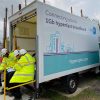Fibrus Bring Rural UK FTTP Broadband Network to 250,000 Premises

Infracapital-backed broadband ISP Fibrus, which is rolling out a new 10Gbps capable Fibre-to-the-Premises (FTTP) network across both Northern Ireland and the North of England (Scotland will follow), has issued a progress update that reveals they’ve now covered around 250,000 premises and have 36,000 customers (take-up of c.15%).
Just to clarify that a bit, Fibrus actually puts the figure for the end of March 2023 as having passed 256,000 premises with 240,000 ‘Ready for Service‘ (RFS), which is up from the 200,000 premises they reported at the end of December 2022. But the operator is aiming to reach a total of 1 million premises over the next 3 years (by Q1 2026), including around 450,000 premises in N.Ireland, with the rest from England and Scotland.
The operator also appears to have revised its coverage targets for March 2024 to 400,000 premises (150,000 in a year), which follows the award of the government (Project Gigabit) contract in Cumbria and their resources focused on getting that project mobilized.
Advertisement
On top of that, Fibrus has also increased its ambitions in Northern Ireland, forecasting that a higher number of its million homes target could be delivered in this region. As a result, they now expect to cover 450,000 premises across N.Ireland, which is approximately 50% of homes in the region (that’s up from their original goal of 350,000).
The provider’s boss now believes that the main challenge for Alternative Networks (AltNets), like his, rests with the difficulty of attracting customers and building a brand. But so far, they appear to be going in the right direction and look to be in a stronger position than a lot of others.
Dominic Kearns, Fibrus co-founder and CEO, said:
“To increase coverage by 150% in one year is an awesome achievement, but to do so whilst simultaneously driving our customer numbers fivefold is especially pleasing.
The Fibrus brand is becoming trusted in the areas we serve, and this is no accident. We believe our focus on offering affordable prices, quality, and service. We know these factors make our customers happy and that’s why people are joining Fibrus in their droves.”
Fibrus has promised never to raise customer prices mid-contract and, according to the CEO, this has prompted an influx of new customers escaping price hikes elsewhere. “The tide is going out and it’s going to be interesting to see who’s wearing swimwear,” added Kearns. “If altnets aren’t building at scale by now, the opportunity is dead for them but operating a scale network is significantly more challenging. … BT is deploying every step in the incumbent playbook to kill off the smaller players.”
The reference to BT above is partly a nod to the current drama over Openreach’s proposed Equinox 2 discounts on wholesale FTTP products and some of the controversial comments that were recently made by BT Group’s CEO (here). “Although retail is our focus right now, the Equinox pricing strategy should be a major concern for Ofcom” said Kearns.
Advertisement
Kearns continued: “BT threading the needle in terms of the regulation should not be their reason for letting this pass through – they need to actually listen to the market that they are there to protect. If Ofcom does not recognise Equinox for what it is and waves through Equinox 2, that would be a massive call and I wouldn’t like to be an altnet relying on wholesale to deliver my business case.”
Over the past twelve months, Fibrus has also invested in improving the resilience and capacity of its core network by removing reliance on third party providers and building a substantial backhaul network. The company also said it hoped the investment in network quality and customer experience will enable it to continue to grow penetration.
Customers of Fibrus typically pay from £39.99 (discounted to £19.99) per month for an unlimited 150Mbps (30Mbps upload) package with an included router and free installation, which rises to £59.99 (discounted to £44.99) per month for their top 1000Mbps (300Mbps upload) tier on a 24-month contract term. The service discounts may vary between different parts of their build, and some can benefit from 3 months of free service.
Mark is a professional technology writer, IT consultant and computer engineer from Dorset (England), he also founded ISPreview in 1999 and enjoys analysing the latest telecoms and broadband developments. Find me on X (Twitter), Mastodon, Facebook, BlueSky, Threads.net and Linkedin.
Ovo Energy May Acquire Shell Energy’s UK Customer Base »























































That’s a biiiiiiig number fudge right there
What did I miss?
Not miss but the number reported is off by a ton. If Fibrus had a number that high then it would be featuring in articles such as this
https://www.ispreview.co.uk/index.php/2023/03/the-top-10-full-fibre-alternative-networks-by-estimated-uk-coverage.html
I completely disagree with the “altnet bubble” mob but fudging the numbers like this completely undermines confidence in the market
Not necessarily, as they’re now building at a much more rapid pace than just a few short months ago and TBB also needs time to catch-up with that. I suspect they’d be just below ITS in that table. On the other hand, it’s wise never to completely trust the official figures that operators put out.
So you agree with me – they have less than 185k yet they claim 255k, hence number fudge of at least 70k difference
Less than 185k in terms of what TBB has so far been able to track, but not necessarily in how much coverage they’ve actually built and put live. Personally, I tend to just take a middle figure between TBB’s data and the official claims.
Fibrus doesn’t do fudge. You assume incorrectly that TBB data is accurate and up to date. We are working with TBB to provide them with our coverage data. Many of our premises are in the most rural parts of Northern Ireland and not easy found by them as they check postcodes.
Ok looking forward to seeing those numbers go up and not prove the fudge like Hyperoptic and Lightspeed
The data in terms of figures and map footprint is what I’ve been able to find, and with the increasing number of roll-outs it is a case of slicing time to spread it around the various networks. There was a period in the last 3 months where finding new Fibrus coverage was difficult, and find nothing after a short while I move onto another provider. Things have improved somewhat and with no data from Fibrus added an extra 1,600 premises yesterday and 3,300 in the last 7 days. Current footprint is 167,997 premises.
Obviously once Fibrus share any detail on areas no doubt I’ll be able to add things at a faster pace, since it should be a much higher hit rate.
What I have no visibility of is how much of their roll-out has gone live in the last few weeks and thus I’d have just seen a burst in a few weeks as a cycle across Northern Ireland. Each quarter we do a search through the slow postcodes as these should be those Project Stratum is hitting.
Annoyingly there is lots of overlaps going on with many providers, and this is messing up attempts to hit 50% UK FTTP coverage.
“BT threading the needle in terms of the regulation should not be their reason for letting this pass through – they need to actually listen to the market that they are there to protect”
If Openreach are operating within OFCOM’s guidelines, on any offers, how could Equinox 2 be blocked? Is he suggesting that OFCOM should block Equinox 2 purely because they can? Surely that’d be anticompetitive.
There is a case being made that Ofcom’s workings may be incorrect and that Equinox 2 might actually push prices below the regulator’s own acceptance level. This is currently being checked, hence part of the reason for the delay. But if Ofcom did find fault in their own approach, then they might have to block or limit the offer under their own rules.
I would think Openreach’s Legal & Regulatory team would have been really careful about how they structured any offers.
Did OFCOM set a minimum level in respect of pricing? I seem to remember references to a charge control price cap in relation to 40/10, but nothing in relation to other speeds. Area 1 shouldn’t be an issue, since OFCOM have stated they wont regulate Openreach’s broadband products and I believe they also ruled out adaptive regulation for Area’s 2 and 3, which would have required Openreach to set minimum price floors as other networks built out in those areas.
OFCOM probably don’t have a case to stop Openreach offering lower pricing, under Equinox 2, since reducing prices in itself isn’t anticompetitive, or predatory, as long as it isn’t below the cost of providing the service.
OFCOM probably didn’t initially object to the Equinox 2 offer, as Openreach likely ensured it adhered to the WFTMR; The reason for the current delay may be due to OFCOM examining its own legal position. It’ll be really interesting to see how OFCOM threads this needle.
Ofcom need to take a very close look at whether Openreach are leveraging SMP here. I’m not talking about pricing, I’m talking about incentives to use Openreach over alternative wholesale providers.
Those are the bits that concern, not the pricing. A reasonable case can be made that as take up is higher than expected prices come down due to volume.
Anything that uses that Openreach are the current access network provider of other products to induce usage of them for FTTP should be a no-no. If it isn’t Ofcom have failed.